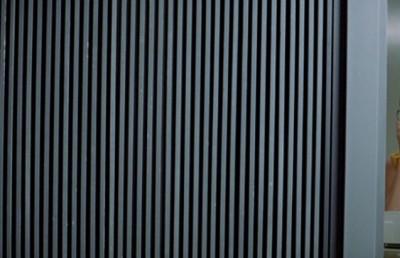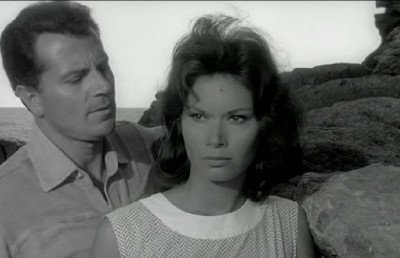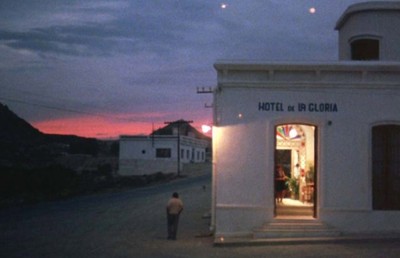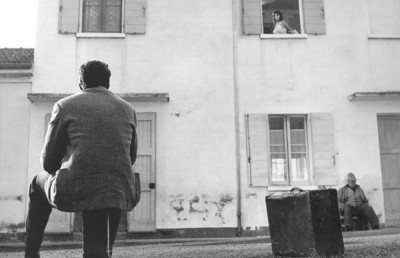Fragile Images and Concrete Things
Indirect Subjectivity and the Externalization of The Soul in Michelangelo Antonioni's Tetralogy
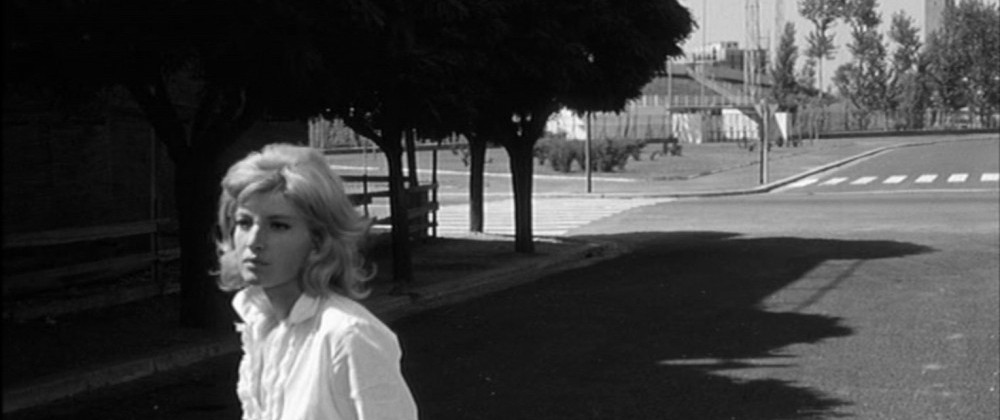
“It’s like this, Mr. Locke: You work with words, images, fragile things. I come with merchandise, concrete things. They understand me straight away.”
-Robertson in The Passenger
Michelangelo Antonioni’s cinematic style poses a challenge to any critic attempting to decode it, solely on the basis that Antonioni disregards so many normative techniques that appear essential to the construction of a film. One could easily dismiss his films as agonizingly tedious and plotless, or conversely, praise them for their poetic images and hypnotic stories. This division stems from a rejection of standardized filmmaking methods, which is prompted by Antonioni’s desire to depict the world as he perceives it: lucid and transitory, both within and outside of the individual. The visual component of his films falls in line with this revised perspective of existence, specifically in the use of point-of-view in his trilogy (L’Avventura, La Notte, L’Eclisse). Emphasizing characters who are alienated from the world about them, Antonioni’s camera mirrors the state of his subjects. In accord with the paradoxical nature of alienation, or the “retreat of the self from itself into itself” (Moore 22), the ontological state of the camera in the tetralogy is situated in a paradox of its own: Antonioni’s cinema rejects both the standard objective camera present in Italian Neorealism as well as the invisible subjective camera utilized in Hollywood productions. Instead, fragile notions and inchoate sensations are drawn out from the individual and cast into the physical fabric beyond the character but within the frame, cementing fleeting angst and passions into concrete objects as refractions of the soul. Hereby, Antonioni makes use of objective perspective to mediate the subjective voice of the author in order to explore the interiors of his alienated characters.
It is necessary to historicize Antonioni’s style to understand it as a progression, or rather an evolution, of Italian Neorealism. This movement in Italian cinema represented “the attempt to document the social, materialist conditions of existence” (Bondanella 191), but Antonioni felt uncomfortable with this interpretation of being. He acknowledges himself that Neorealism was “the type of film appropriate and necessary for its time” (Antonioni 22), but the function of Neorealism clashed with his view of the world and those populating it. This opposing perspective is best articulated by Antonioni himself:
…perhaps it was no longer so important … to examine the relationship between the individual and his environment, as it was to examine the individual himself, to look inside the individual and see … symptoms of such restlessness and such behaviour which began to outline the changes and transitions that later came about in our psychology, our feelings, and perhaps even our morality. (Antonioni 22-23)
With this critique of objective realism, Antonioni’s films move from the exterior world to the interior of the individual, and explore the sense of alienation which pervades his protagonists. Moore defines this alienation as what “arises when the self becomes disenchanted with the world and retreats into itself, oftentimes to reflect upon its relations with the world and its relationship with others” (Moore 22). This alienation permeates through all of Antonioni’s protagonists, from Aldo in Il Grido to Giuliana in Il Deserto Rosso. The retreat into oneself takes primacy within his stories, however he takes precaution not to emphasize alienation explicitly, but rather alienation as an aspect of the modern man. In discussing his films, Antonioni carefully avoids ascribing alienation as the core of his films. Instead he declares that “the world around and inside us is unstable. I am making films on the instability of feelings, on the mystery of feelings” (Antonioni 20). He prefers to side-step the term alienation entirely, stating: “I never think in terms of alienation; it’s the others who do … If I do make films about alienation – to use that word that is so ambiguous – they are about characters, not about me” (Antonioni 151).
Antonioni’s technical style seeks to penetrate these alienated, or rather, unstable characters who themselves are unsure of where they are situated in their universe. But if his cinematic goal was truly “to put the camera inside the characters – not outside” (Antonioni 159), this would become quite difficult as his subjects collapse in upon themselves, shedding their personas in the process. The interiors of the subjects are therefore reduced to a series of conditions or potentialities drifting through the world about them rather than structured systems of definitive wants and desires. Anna personifies this in L’Avventura when she tries to explain to Claudia why she isn’t excited to reunite with Sandro (DVD Timecode 5:22 – 6:05). Her desires are abstract, and when presented in reality they fail to satisfy. In this sense Anna desires without intention, and any object of her perception is supplanted by how she perceives it. This is functionally true of all of Antonioni’s characters, whom are all captured in the process of transformation.
In the same sense that his characters exist ambiguously, lost within themselves and their surroundings, Antonioni’s camera operates with the same ambiguity. Specifically, it endeavours to excavate the isolation present within his protagonists, but at the same time it retains a distanced position of spectatorship. Chatman echoes this idea, noting that “though it can identify with a character’s point of view when that suits its purposes, it usually preserves its own identity” (“The Great Tetralogy” 114). This appears to clash with Antonioni’s profession of wanting to place the camera inside of the subject; however this incompatibility between objectivity and subjectivity occurs only on a simple, technical level where subjectivity and physical perspective are blurred together. Artistically, Antonioni’s fascination gravitates to the souls of his characters, but on a more materialistic level he recognizes that the camera functions solely with exteriors. It is through the actions of his subjects that they reveal their thoughts and emotions. Antonioni summarizes this as “our acts, our gestures, our words are nothing more than the consequences of our own personal situation in relation to the world around us” (Antonioni 26).
If we turn to L’Eclisse (1962), we can see this superimposition of subjective camera and objective narration quite clearly. After finishing “playing negro” at her neighbour Marta’s apartment, Vittoria is invited to come fly in an airplane with Marta and her husband (DVD Timecode 00:41:49 – 00:45:37). The following segment proves to be one of the more poetic yet simple scenes which occur in the film. Most striking is the way it begins: with a straight cut from Vittoria in her apartment to a shot looking out the window of the plane at the runway racing by. This shot, which endures for fifteen seconds, seems to emerge from nowhere; there was no prior confirmation that Vittoria would be accompanying Marta for the plane ride. Likewise, we are first thrown into the scene from a very obscured angle, able to make out only a fragment of the wing in the upper left corner of the frame. It seems confusing to begin the scene with this limited vantage and to hold it for such an extensive duration, especially when it is followed by the long shot revealing the plane taking off which, by conventional standards, should have preceded the prior constrained perspective [1]. Antonioni’s intention for introducing us to the setting from this unusual angle is not revealed until roughly one minute into the scene (DVD Timecode 0:42:33). It is at this point that we are presented with a two-shot of Vittoria and Marta seated in the back of the plane and can appreciate that our perspective was anchored to the same point-of-view as Vittoria. But there has been a span of three different shots wedged between our first viewpoint out the window and the revelation of our spatial proximity to Vittoria. Whether or not the spectator is given a privileged view from her subjectivity is tentative, though irrelevant. Nothing is learned about how Vittoria felt as she stared out the window during take-off (if it even was her viewpoint in the first place), because the viewer is denied a counter-shot to convey the inhabited subject’s reaction.
Ambiguity is present in the grammatical construction of the aviation sequence, insofar as it strays from the conventional point-of-view editing system. Not every point-of-view is related directly back to the character, or even tied together in a consistent temporal flow, occasionally cutting out certain blocks of time. This coincides with Brunette’s observation that “these purposeful narrative, generic, spatial, and temporal dislocations … augment the film’s depiction of subjectivity or identity as something fluid and contradictory” (133). This sequence situates us intimately alongside Vittoria as she revels in viewing her world from an inhuman, possibly divine, perspective, but this does not translate literally. Rather, the audience is privy to the protagonist’s experience as well as the event of flying itself and the two are conjoined somewhere in the void between.
In discussing point-of-view in cinematic terms, Chatman extrapolates his predetermined concepts of slant, the angle of perspective belonging to the narrator, and filter, the perception of events through the character’s eyes, but finds them in need of readjustment when translated from literature to film. In opposition to literary storytelling, cinematic exposition is founded on a primarily visual basis, and this implies a presentation of images which persists as the director’s slant even “when it is temporarily mediated by the character’s perceptual filter” (Chatman, “Coming to Terms” 157). Perceptual filter is distinct from his use of the term interest-focus, which describes a more abstract inclination toward the character’s mindset and permits the audience to identify with the subject on a “social” basis. Interest-focus can thus also extend from a single character to a group, though in so doing it weakens its subjective qualities into a more contextual perspective. In this regard, the cinematic image is able to conform space to the characters’ immediate perception of it, but can also represent the world as they conceive of it beyond the field of their own vision.
Returning to L’Eclisse, we can see an example of how Antonioni both employs and tampers with the Interest-focus of his characters. The second time we see Vittoria enter the Borsa stock exchange, she participates in a moment of silence for a stockbroker who had died earlier that day (DVD Timecode 22:39 – 24:19). The reverence of the moment is articulated both visually and audibly through allusion on the director’s behalf. The wide open hall of the Borsa, in conjunction with the massive pillars planted throughout the room, is shown through a wide angle positioned high up above the heads of everyone in the room. The interior is presented from roughly the same locus as Vittoria, but definitely not from her literal perspective. Phones continue ringing over the hallow silence of the room, echoing throughout the chamber. As the audience is presented with the long shot of the stock exchange, the blend of the huge cathedral-like hall; the silent people in reverence; and the phones ringing, altered through the reverberations off of the stone walls and resembling the sound of bells, conjure similes to a religious wake.
The spiritual slant of the scene seems to coincide with Vittoria’s feelings regarding the event. After Piero mocks the formality of the event, comparing it to an athlete’s memorial service, she asks him if he knew the departed, to which he shrugs and replies, “one minute here costs billions”. Vittoria neither nods in agreement nor seems shocked at his insensitivity, but rather simply pulls away. Immediately following that shot is a frame in which Vittoria and Piero are composed on opposite sides of the screen, separated by a pillar. Soon after, the silence ends with the ringing of a bell resembling the starting bell at a racetrack, and the cathedral quality of the stock exchange reverts back to its “boxing ring”. Vittoria speaks very little during the scene, nor do we experience any vantages contiguous to her own, but through the mise-en-scène we can infer how the event impressed upon her.
Antonioni treats the scene relatively objectively in its presentation through the camera, and Vittoria’s perceptual filter only mediates when she inquires and reacts to Piero’s comments, which consists of minimal dialogue. It is instead through the juxtaposition of the space at differing intervals that we can associate the desires of the two characters. Piero’s perspective of the space conforms to the interspersed shots of the stockbrokers madly clamouring over one another, while Vittoria’s interests lie in the man being remembered and identify with the sombre religious tone. When we return to the chaos familiar to the stock exchange, the audience now perceives the room in two different terms: either as the sport Piero sees in it, or as a religious communion. The variance in the two characters is represented by the pillar which divides them. We do not understand the contrast between their individual psychologies any better, as the event doesn’t provide any material basis for the progression of the story. Instead Antonioni favours the divide between the two characters, and this is evident quite literally in the size of the pillar which separates them. In so far as the stock exchange is filtered as either frenzied or religious, these are mere interest-focuses of the two characters. Neither perception of the space is absolute; they can only be inferred liberally. The contrast between the two ideologies is highlighted more concretely in the pillar than in their actions.
The gulf between characters is the true substance of Antonioni’s films. In L’Avventura when Patrizia frowns and says “Islands…I don’t get them…surrounded by nothing but water…poor things” (DVD Timecode 16:20 – 16:27), this statement bears more weight than its casual delivery. Metaphorically, Antonioni conceives of these people as islands, and it is the water between them which makes them so. However, this metaphor isn’t realized visually until the search party commences after Anna’s disappearance. While searching for her, there is a straight cut to the churning water in a crevasse on the island (DVD Timecode 29:06 – 29:45). Panning right along the walls of the cliffs, we can see the violence of the waves crashing about on the rocks, yet we do not see any other subjects in the frame for another twelve seconds, at which time Sandro appears and briefly scans the gully in a fraction of the time the pan spent scouring the space. Here the camera is searching for Anna autonomously instead of following the characters’ search. It retains the interest-focus of the group, yet when Sandro is introduced, his interest in the gulf endures for only a portion of the presentation. Indeed the audience is looking for Anna’s body, but it is never shown straightforwardly. Whether or not Anna has actually flung herself into the sea and died is relatively irrelevant to the plot; it is more important that she is missing. Her disappearance is the reason that Claudia and Sandro become involved, but she is also the wedge preventing them from doing so harmoniously. In a figurative sense, Anna has indeed been swallowed by that gulf, and when the camera pans up to show Claudia drifting along on the other side of the gully Antonioni has already foreshadowed the rift between Claudia and Sandro in a poetic way. Thus without resorting to conventional means of expressing the characters’ inner turmoil, Antonioni portrays the external strait between the two through visually poetic means.
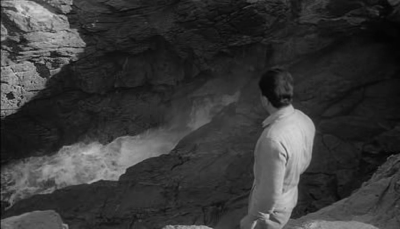
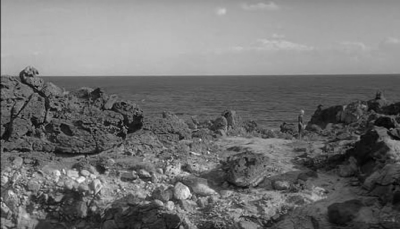
Thus, Michelangelo Antonioni’s films reflect his desire to portray the world which his characters inhabit as they experience it, but his intentions lie in the subjective experience of the characters themselves. Problematically, it is the environment that they live in which forces them into a state of alienation wherein they sit in an uncertain state. In order to portray this state of alienation, Antonioni’s camera branches out into the void between the inner psyche and the outer stratum, and in so doing reflects both their universes as well as their souls. As a result, Antonioni films their stories objectively in order to reveal the reverberations of their inner stirrings, turning his subjects inside out so that their surfaces convey their frames of mind. Considering this, Robertson’s assessment of the distinction between his and Locke’s method of communicating can be seen as a kind of self-diagnosis of Antonioni’s own visual style. Granted, words and images form the bedrock of any cinematic endeavour, and in this way Antonioni is bound, like Locke, to these very fragile words and images, and they are fragile insofar as they are abstractions that seek to render experience itself into some effable form. Yet, as we have seen in these films that compose the pinnacle of the director’s work, it is the concrete quality that Antonioni endows the images with – the entanglement of mise-en-scène into the character’s consciousness – which substantiates his approach and, as Locke will do in The Passenger, blurs the boundaries between the two aesthetic identities, creating a poetic impression of human experience which we can only define as Antonionian.
Endnotes
1 In fact, Antonioni follows this standard editing style in Zabriskie Point when Mark steals that plane, establishing the character’s position in the frame, thereby anchoring the later shots to his own physical POV.
Work Cited
Antonioni, Michelangelo. The Architecture of Vision: Writings and Interviews on Cinema. New York: Marsilio Publishers, 1996.
Brunette, Peter. “The Passenger.” The Films of Michelangelo Antonioni. Cambridge: Cambridge University Press, 1998, 133-143.
Bondanella, Peter, and Andrea Ciccarelli, ed. The Cambridge Companion to: The Italian Novel. New York: Cambridge University Press, 2003.
Chatman, Seymour. Coming to Terms: The Rhetoric of Narrative in Fiction and Film. New York: Cornell University Press, 1990.
Chatman, Seymour. “The Great Tetralogy: Cinematic Form.” Antonioni: or, the Surface of the World. Berkeley: University of California Press, 1985, 114-135.
Moore, Kevin Z. “Eclipsing the Commonplace: The Logic of Alienation in Antonioni’s Cinema.” Film Quarterly, v. 48 (Summer 1995): 22-34.


